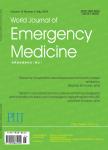Left-sided vagus nerve stimulation improves cardiopulmonary resuscitation outcomes in rats as effectively as right-sided vagus nerve stimulation
Left-sided vagus nerve stimulation improves cardiopulmonary resuscitation outcomes in rats as effectively as right-sided vagus nerve stimulation作者机构:Department of Emergency MedicineUnion HospitalTongji Medical CollegeHuazhong University of Science and TechnologyWuhan 430022China Department of Intensive Care UnitWuhan Hospital of Traditional Chinese MedicineWuhan 430000China Department of Emergency Medicinethe Second Affi liated Hospital of Zhejiang University School of MedicineHangzhou 310009China Department of Emergency MedicineHankou Branch of Central Theater General HospitalWuhan 430070China Department of UltrasoundUnion HospitalTongji Medical CollegeHuazhong University of Science and TechnologyWuhan 430022China Department of AnesthesiologyUnion HospitalTongji Medical CollegeHuazhong University of Science and TechnologyWuhan 430022China
出 版 物:《World Journal of Emergency Medicine》 (世界急诊医学杂志(英文))
年 卷 期:2021年第12卷第4期
页 面:309-316页
核心收录:
基 金:supported by research grants from the National Natural Science Foundation of China (81571866 82072137)。
主 题:Vagus nerve stimulation Cardiac arrest Tumor necrosis factor-alpha Myocardial function α-7 nicotinic acetylcholine receptor
摘 要:BACKGROUND: Our group previously reported that right-sided vagus nerve stimulation(RVNS) significantly improved outcomes after cardiopulmonary resuscitation(CPR) in a rat model of cardiac arrest(CA). However, whether left-sided vagus nerve stimulation(LVNS) could achieve the same effect as RVNS in CPR outcomes remains unknown.METHODS: A rat model of CA was established using modified percutaneous epicardial electrical stimulation to induce ventricular fibrillation(VF). Rats were treated with LVNS or RVNS for 30 minutes before the induction of VF. All animals were observed closely within 72 hours after return of spontaneous circulation(ROSC), and their health and behavior were evaluated every 24 hours.RESULTS: Compared with those in the RVNS group, the hemodynamic measurements in the LVNS group decreased more notably. Vagus nerve stimulation(VNS) decreased the serum levels of tumor necrosis factor-alpha(TNF-α) and the arrhythmia score, and attenuated inflammatory infiltration in myocardial tissue after ROSC, regardless of the side of stimulation, compared with findings in the CPR group. Both LVNS and RVNS ameliorated myocardial function and increased the expression of α-7 nicotinic acetylcholine receptor in the myocardium after ROSC. Moreover, a clear improvement in 72-hour survival was shown with VNS pre-treatment, with no significant difference in efficacy when comparing the laterality of stimulation. CONCLUSIONS: LVNS may have similar effects as RVNS on improving outcomes after CPR.



